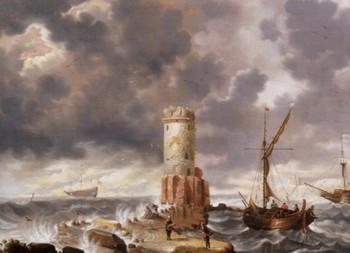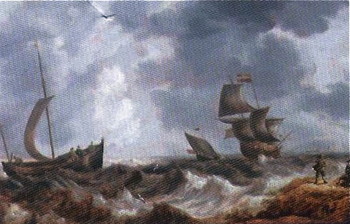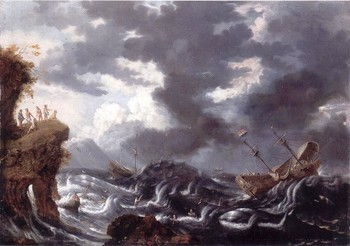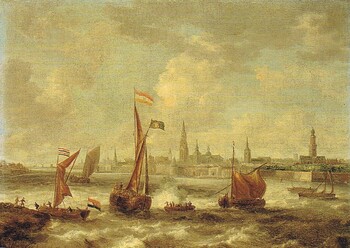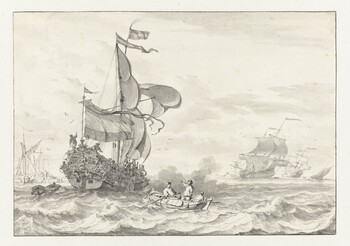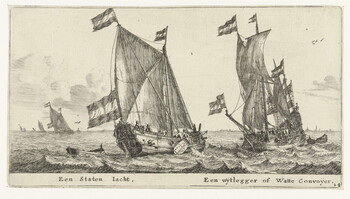Cornelis Mahu
(Re-attributed to by C.J.A. Wansink of the RKD, The Hague)
Sold as Bonaventura Peeters I
Ships in a storm off the South American coast
Oil on panel : 57,5 X 80,3 cm
Unsigned
Sold at Christie's London, 13/12/96
For 8.050 £ =10.560 €
This is a comparative item
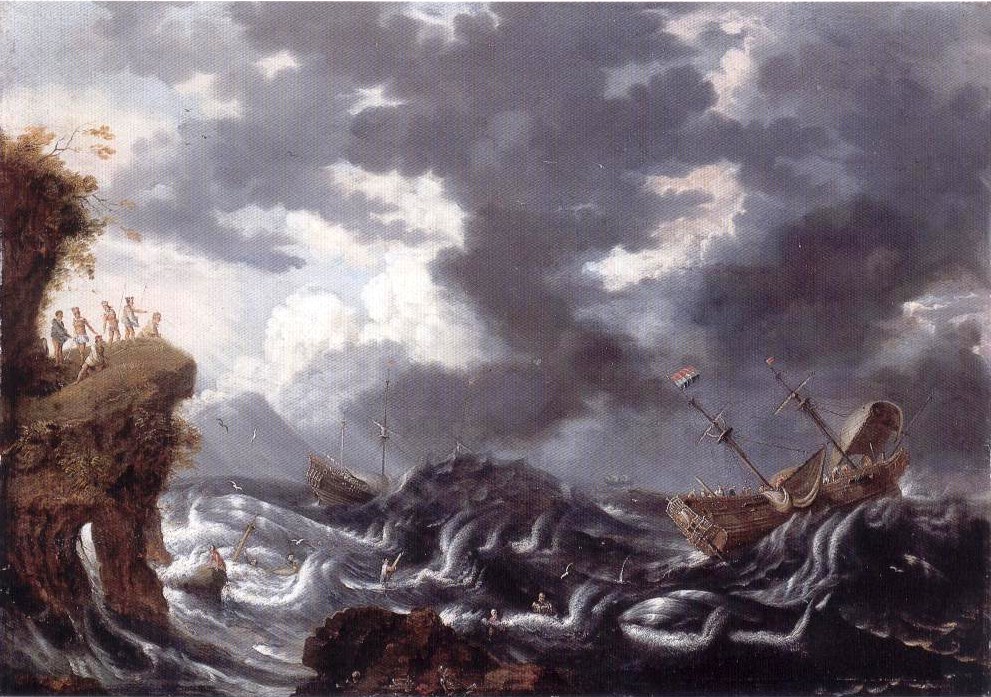
Painting for Sale
In short
Cornelis Mahu was a versatile Flemish painter, active in Antwerp.
Most of Mahu’s marine paintings are influenced by his fellow citizens the brothers Bonaventura I and Jan I Peeters. Like them he often painted for the Dutch market.
A lot of luxury yachts were build during the 17th and 18th century on Dutch shipyards for local, but also for international clients.
About Cornelis Mahu
Flemish painter
Antwerp 1613 – 1689 Antwerp
Mahu became a Master in the Antwerp Guild of Saint Luke in the year 1638/39.
Although a Flemish painter some of his paintings look very Dutch. The reason is simple. In 1633 Mahu married Brigitta Wolfvoet. Her father, Victor Woflvoet I, and her brother, Victor II, were art dealers; they sold a lot of Dutch paintings. Cornelis Mahu must have learned Dutch painting through them; some old scholars erroneously thought he might have been a pupil of Willem Claesz. Heda, for in his early years Mahu regularly copied still lifes by this famous master.
Cornelis Mahu was a very versatile painter. He painted
- marine paintings influenced by the Flemish painters Bonaventura I and Jan I Peeters, some also by the Dutch painter Jan Porcellis.
- still lifes, some very Dutch, Protestant “ontbijtjes” influenced by Willem Claesz. and Gerrit Willemsz. Heda, but also Flemish still lifes reminding of Jan Pauwel Gillemans I.
- genre scenes, inspired by the Flemish painter David Teniers II or by the Dutch painter Adriaen van Ostade. Cornelis’ son, Victor (circa 1665 – 1700/01), continued painting genre scenes in his father’s footsteps.
Cornelis had, besides his son Victor, three pupils: the best known one was the flower still life painter Gaspar Peeter Verbruggen I (1635 – 1681).
About Dutch yachts
A yacht was a not too small (17 – 20m), fast, manageable, richly decorated, luxury sailing ship. Yachts were conceived as smaller versions of Dutch East Indiamen, commercial ships used by the East Indies Company. Typical of these ships and of the yachts was their flat transom (“spiegel”), decorated with a coat of arms.
They were used:
- by the Stadtholder (princely yacht),
- by members of the States General (States yacht, “Staatsiejacht”),
- by member of the West or the East Indies Company (WIC and VOC yacht),
- by certain towns (Amsterdam for example) or admiralties (admiralty yacht).
The first yacht, called Neptune, was a war yacht build for Prince Maurice in 1595 by the Admiralty of Rotterdam (“Admiraliteit van de Maze”). In later yachts the representative function prevailed over its war tasks: they got richly decorated with sculptures and a pavilion was added at the backside to provide with luxury quarters for its distinguished guests. The flat transom with lantern, the figurehead at the prow and the canons still remind of its initial military function.
The centerboards, one on each side, could be used against the drift motion in shallow waters.
Dutch yachts remained very popular until the end of the 18th century, not only in Holland, but also abroad in England, Germany and Sweden. It is thought that some two hundred yachts were built in Holland during that period for domestic and foreign clients.
Stadtholder Frederic Henry, the successor and half brother of Prince Maurice, possessed a complete fleet of yachts: a large war yacht used at sea, a smaller one for the numerous Dutch inland waterways, several sail- and horse-drawn yachts for canals and even a smaller play yacht (“speeljacht”).
An important feature of yachts, especially of the princely yachts, were their canons, usually twelve, for firing salutes.
Why should you buy this painting?
Because it is such a decorative maritime scene.
Comparative paintings
Click photos for more details

